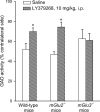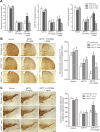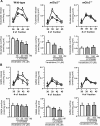The use of knock-out mice unravels distinct roles for mGlu2 and mGlu3 metabotropic glutamate receptors in mechanisms of neurodegeneration/neuroprotection
- PMID: 17670976
- PMCID: PMC6673047
- DOI: 10.1523/JNEUROSCI.1889-07.2007
The use of knock-out mice unravels distinct roles for mGlu2 and mGlu3 metabotropic glutamate receptors in mechanisms of neurodegeneration/neuroprotection
Abstract
Dual metabotropic glutamate 2/3 (mGlu2/3) receptor agonists have been examined with success in the clinic with positive proof of efficacy in several tests of anxiety and schizophrenia. Moreover, a large body of evidence has accumulated that these drugs have significant neuroprotective potential. An important discussion in the field deals with dissecting effects on mGlu2 versus effects on mGlu3 receptors, which is relevant for the potential use of subtype-selective agonists or allosteric activators. We addressed this issue using mGlu2 and mGlu3 receptor knock-out mice. We used mixed cultures of cortical cells in which astrocytes and neurons were plated at different times and could therefore originate from different mice. Cultures were challenged with NMDA for the induction of excitotoxic neuronal death. The mGlu2/3 receptor agonist, (-)-2-oxa-4-aminocyclo[3.1.0]hexane-4,6-dicarboxylic acid (LY379268), was equally neuroprotective in cultures containing neurons from wild-type, mGlu2-/-, or mGlu3-/- mice. Neuroprotection was instead abolished when astrocytes lacked mGlu3 receptors, unless neuronal mGlu2 receptors were also absent. The latter condition partially restored the protective activity of LY379268. Cultures in which neurons originated from mGlu2-/- mice were also intrinsically resistant to NMDA toxicity. In in vivo experiments, systemic administration of LY379268 protected striatal neurons against NMDA toxicity in wild-type and mGlu2-/- mice but not in mGlu3-/- mice. In addition, LY379268 was protective against nigrostriatal degeneration induced by low doses of 1-methyl-4-phenyl-1,2,3,6-tetrahydropyridine only in mice lacking mGlu2 receptors. We conclude that neuroprotection by mGlu2/3 receptor agonists requires the activation of astrocytic mGlu3 receptors, whereas, unexpectedly, activation of mGlu2 receptors might be harmful to neurons exposed to toxic insults.
Figures









Similar articles
-
Targeting group II metabotropic glutamate (mGlu) receptors for the treatment of psychosis associated with Alzheimer's disease: selective activation of mGlu2 receptors amplifies beta-amyloid toxicity in cultured neurons, whereas dual activation of mGlu2 and mGlu3 receptors is neuroprotective.Mol Pharmacol. 2011 Mar;79(3):618-26. doi: 10.1124/mol.110.067488. Epub 2010 Dec 15. Mol Pharmacol. 2011. PMID: 21159998
-
Activation of mGlu3 metabotropic glutamate receptors enhances GDNF and GLT-1 formation in the spinal cord and rescues motor neurons in the SOD-1 mouse model of amyotrophic lateral sclerosis.Neurobiol Dis. 2015 Feb;74:126-36. doi: 10.1016/j.nbd.2014.11.012. Epub 2014 Nov 28. Neurobiol Dis. 2015. PMID: 25434487
-
Anxiolytic-like activity of the mGLU2/3 receptor agonist LY354740 in the elevated plus maze test is disrupted in metabotropic glutamate receptor 2 and 3 knock-out mice.Psychopharmacology (Berl). 2005 Apr;179(1):284-91. doi: 10.1007/s00213-004-2098-x. Epub 2004 Dec 24. Psychopharmacology (Berl). 2005. PMID: 15619115
-
Metabotropic glutamate receptors in neurodegeneration/neuroprotection: still a hot topic?Neurochem Int. 2012 Sep;61(4):559-65. doi: 10.1016/j.neuint.2012.01.017. Epub 2012 Jan 25. Neurochem Int. 2012. PMID: 22306345 Review.
-
Preclinical pharmacology of mGlu2/3 receptor agonists: novel agents for schizophrenia?Curr Drug Targets CNS Neurol Disord. 2002 Apr;1(2):215-25. doi: 10.2174/1568007024606177. Curr Drug Targets CNS Neurol Disord. 2002. PMID: 12769628 Review.
Cited by
-
Metabotropic glutamate receptor 3 is downregulated and its expression is shifted from neurons to astrocytes in the mouse lateral septum during the postpartum period.J Histochem Cytochem. 2015 Jun;63(6):417-26. doi: 10.1369/0022155415578283. Epub 2015 Mar 4. J Histochem Cytochem. 2015. PMID: 25739438 Free PMC article.
-
Metabotropic glutamate receptors: physiology, pharmacology, and disease.Annu Rev Pharmacol Toxicol. 2010;50:295-322. doi: 10.1146/annurev.pharmtox.011008.145533. Annu Rev Pharmacol Toxicol. 2010. PMID: 20055706 Free PMC article. Review.
-
Proteomics and Transcriptomics of the Hippocampus and Cortex in SUDEP and High-Risk SUDEP Patients.Neurology. 2021 May 25;96(21):e2639-e2652. doi: 10.1212/WNL.0000000000011999. Epub 2021 Apr 28. Neurology. 2021. PMID: 33910938 Free PMC article.
-
Activating mGlu3 Metabotropic Glutamate Receptors Rescues Schizophrenia-like Cognitive Deficits Through Metaplastic Adaptations Within the Hippocampus.Biol Psychiatry. 2021 Sep 15;90(6):385-398. doi: 10.1016/j.biopsych.2021.02.970. Epub 2021 Mar 6. Biol Psychiatry. 2021. PMID: 33965197 Free PMC article.
-
G-Protein-Coupled Receptors and Ischemic Stroke: a Focus on Molecular Function and Therapeutic Potential.Mol Neurobiol. 2021 Sep;58(9):4588-4614. doi: 10.1007/s12035-021-02435-5. Epub 2021 Jun 12. Mol Neurobiol. 2021. PMID: 34120294 Review.
References
-
- Ambrosini A, Bresciani L, Fracchia S, Brunello N, Racagni G. Metabotropic glutamate receptors negatively coupled to adenylate cyclase inhibit N-methyl-d-aspartate receptor activity and prevent neurotoxicity in mesencephalic neurons in vitro. Mol Pharmacol. 1995;47:1057–1064. - PubMed
-
- Battaglia G, Monn JA, Schoepp DD. In vivo inhibition of veratridine-evoked release of striatal excitatory amino acids by the group II metabotropic glutamate receptor agonist LY354740 in rats. Neurosci Lett. 1997;229:161–164. - PubMed
-
- Battaglia G, Bruno V, Ngomba TR, Di Grezia R, Copani A, Nicoletti F. Selective activation of group-II metabotropic glutamate receptors is protective against excitotoxic neuronal death. Eur J Pharmacol. 1998;356:271–274. - PubMed
-
- Battaglia G, Bruno V, Pisani A, Centonze D, Catania MV, Calabresi P, Nicoletti F. Selective blockade of type-I metabotropic glutamate receptors induces neuroprotection by enhancing GABAergic transmission. Mol Cell Neurosci. 2001;17:1071–1083. - PubMed
-
- Battaglia G, Busceti LC, Pontarelli F, Fornai F, Paparelli A, Bruno V, Ruggieri S, Nicoletti F. Protective role of group-II metabotropic glutamate receptors against nigro-striatal degeneration induced by 1-methyl-4-phenyl-1,2,3,6-tetrahydropyridine in mice. Neuropharmacology. 2003;45:155–166. - PubMed
Publication types
MeSH terms
Substances
LinkOut - more resources
Full Text Sources
Other Literature Sources
Molecular Biology Databases
